Pressure washing is a must for keeping various exterior surfaces clean and looking their best. Whether you’re fighting stains on your driveway, refreshing your wood deck or prepping your commercial buildings for a professional look, knowing the ins and outs of pressure washing is key. This guide will walk you through the cleaning process for different surfaces and safety and give tips on choosing the suitable pressure washer and nozzle for a smooth cleaning experience.
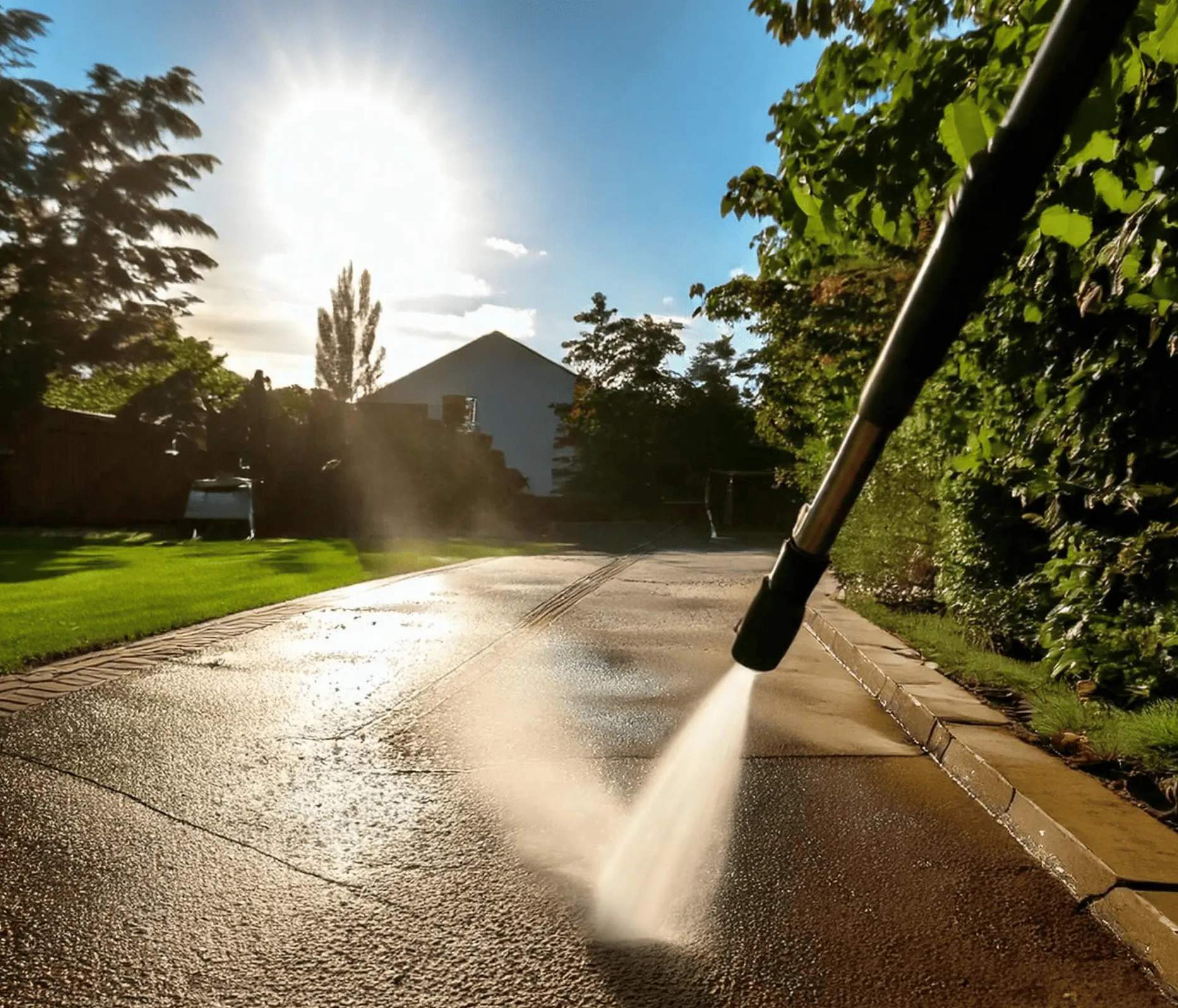
Electric vs. Gas-Powered Pressure Washers
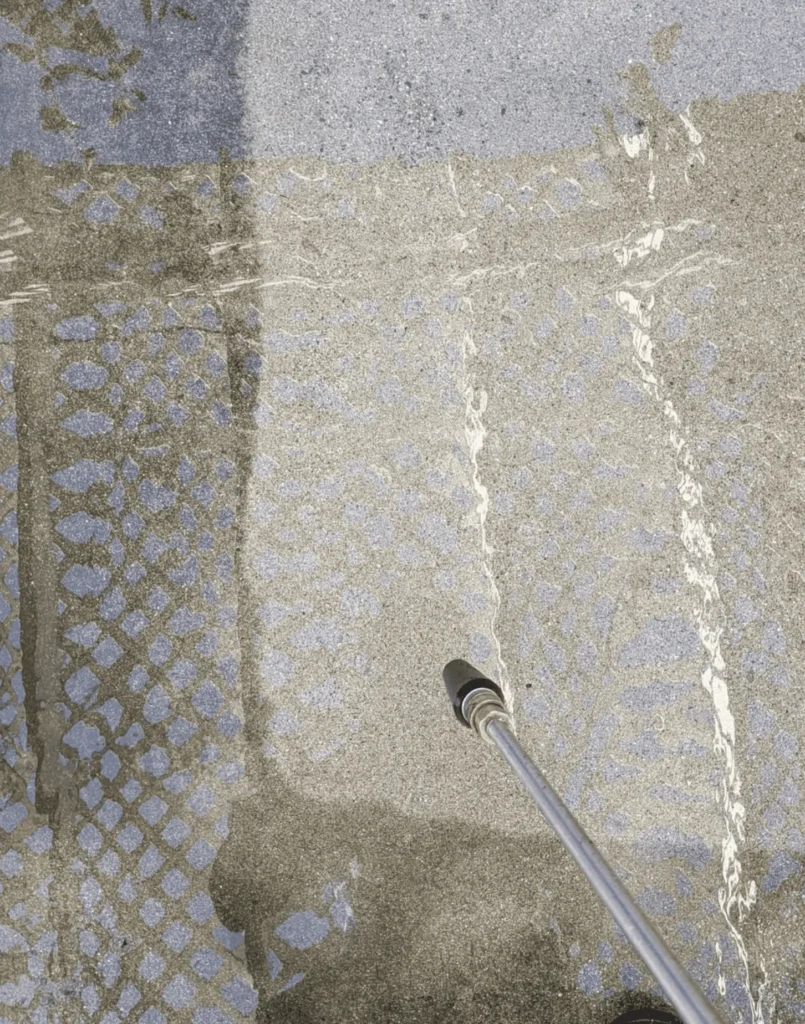
When it comes to pressure washing, the first decision you’ll need to make is electric vs. gas-powered. Each has its pros depending on the job.
Electric Pressure Washers: These are more compact and easier to use, perfect for smaller jobs. They have lower water pressure, which is suitable for delicate surfaces like glass or vinyl siding. Electric are good for residential use where you’ll be cleaning outdoor furniture, patios or exterior house washing of soft surfaces.
Gas-Powered Pressure Washers: For tougher stains and larger surfaces like concrete driveways or commercial buildings, gas-pressure washers have high-pressure water for more aggressive cleaning. These are more durable and can handle a broader range of pressure washing jobs, from cleaning stubborn fabric stains to removing paint chips from unpainted wood.
Pressure Washing Concrete Surfaces and Driveways
Concrete surfaces like driveways and patios are popular targets for pressure washing because they’re durable and prone to stains. However, improperly using a power washer can damage the surface. Here’s how to do it right:
- Pressure: Start with high pressure, 2500-3000 PSI, using the power washer to blast away dirt and oil stains.
- Surface Cleaners: Apply a concrete detergent to the surface before washing. This will help break down tough dirt and grease for better pressure washing.
- Spray Wand Technique: Hold the spray wand at a 45 degree angle, use a concentrated stream for tough stains. Move-in sections to clean the entire surface.
- Safety: Keep a safe distance from the surface to prevent damage, and don’t use a narrow nozzle that can create too much pressure and damage the surface.
Cleaning Wooden Decks and Fences with a Pressure Washer
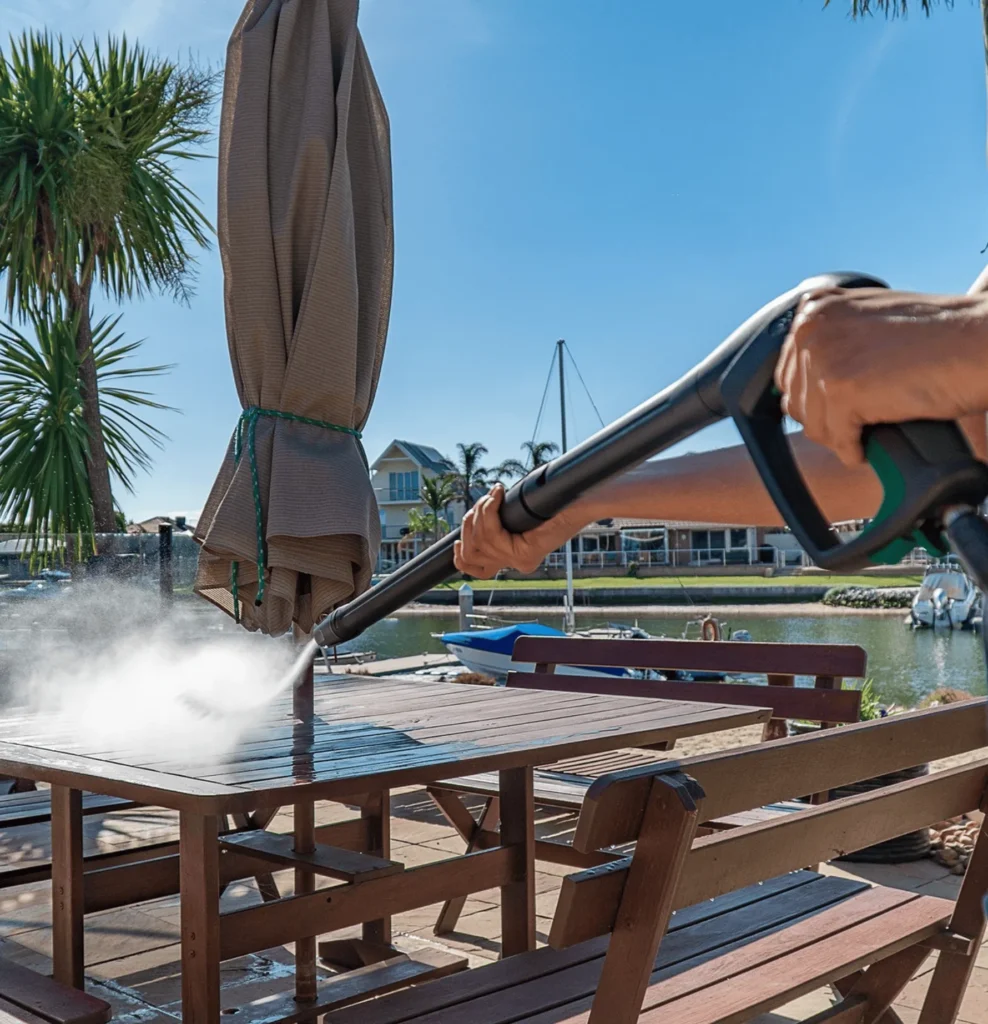
Wooden decks and fences add character to any property but need to be maintained to avoid splintering or discolouration. Here’s how to clean wooden decks without harming them:
- Pressure: Use a lower pressure setting, 500-1200 PSI, to not damage the wood fibers. Start with the lowest pressure setting and increase as needed.
- Testing and Preparation: Test the pressure washer on a small, inconspicuous area to make sure it won’t strip the finish off the wood. Remove any loose debris from the surface before you start.
- Nozzle: A 25-degree spray pattern nozzle is best for wooden surfaces. This gives you a wide spray pattern that distributes the water pressure evenly, reducing the risk of accidental damage.
- Detergent: Apply wood-safe detergent from the detergent reservoir and let it sit for a few minutes before rinsing with cold water. Don’t use hot water, as it will warp the wood.
- Surface Cleaners: After washing, consider applying a sealant to protect the wood from future moisture and UV damage.
Pressure Washing Vinyl Siding: How to Do it Safely
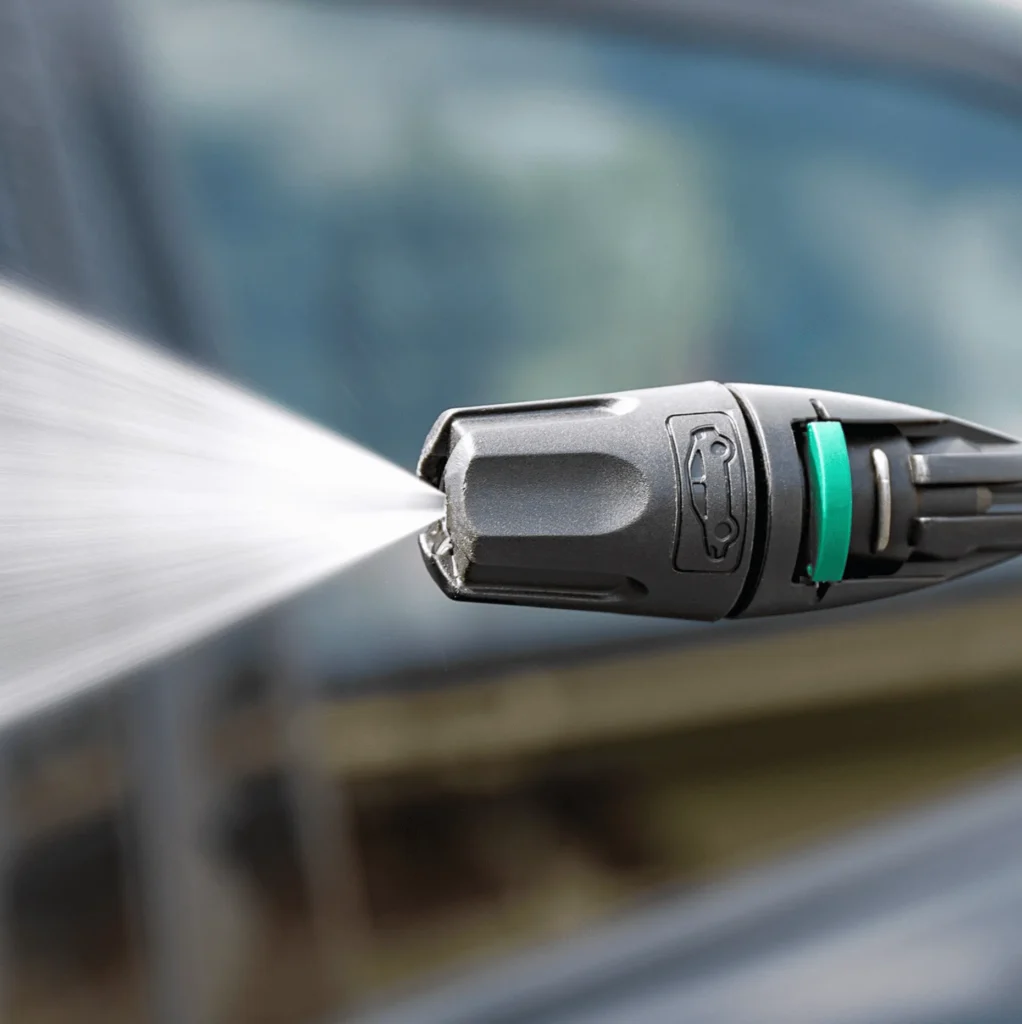
Vinyl siding is an exterior surface that needs to be cleaned regularly to prevent mould and mildew growth. However, improper pressure washing can let water in and cause damage. Follow these tips to clean your vinyl siding safely:
- Pressure: Use a moderate pressure setting, 1300-1600 PSI. This will remove dirt without damaging the siding.
- Wide Spray Pattern: Use a 40-degree nozzle to get a wider fan spray that covers more area and reduces the risk of water getting behind the siding.
- Detergent: Use a siding-safe cleaning solution and apply it with a pressure washer that has a detergent reservoir. Let it sit for 5-10 minutes before rinsing off with a stream of water.
- Safety: Inspect the siding for any cracks or gaps where water can enter. Cover electrical outlets and light fixtures with waterproof tape to prevent water from getting in during the cleaning process.
Brick and Stone Surfaces: High-Pressure Cleaning Challenges
Brick and stone surfaces, whether on a patio, walkway or exterior wall, require a careful balance of power and care. Here’s how to clean these surfaces without causing long-term damage:
- Medium Pressure: Start with 500-1500 PSI. Brick and stone are porous and can be damaged by high pressure if not handled correctly.
- Pre-Wetting: Wet the surface first with low pressure to prevent the detergent from being absorbed too deeply into the porous material.
- Spray Wand Distance: Keep the spray wand at a distance from the surface, use a 25 degree or 40 degree nozzle. This will prevent the concentrated stream from etching the surface.
- Sealing Post Cleaning: After cleaning apply a sealant to protect the brick or stone from moisture and future stains. Especially for outdoor surfaces.
Glass Surfaces and Windows: Streak-Free Shine
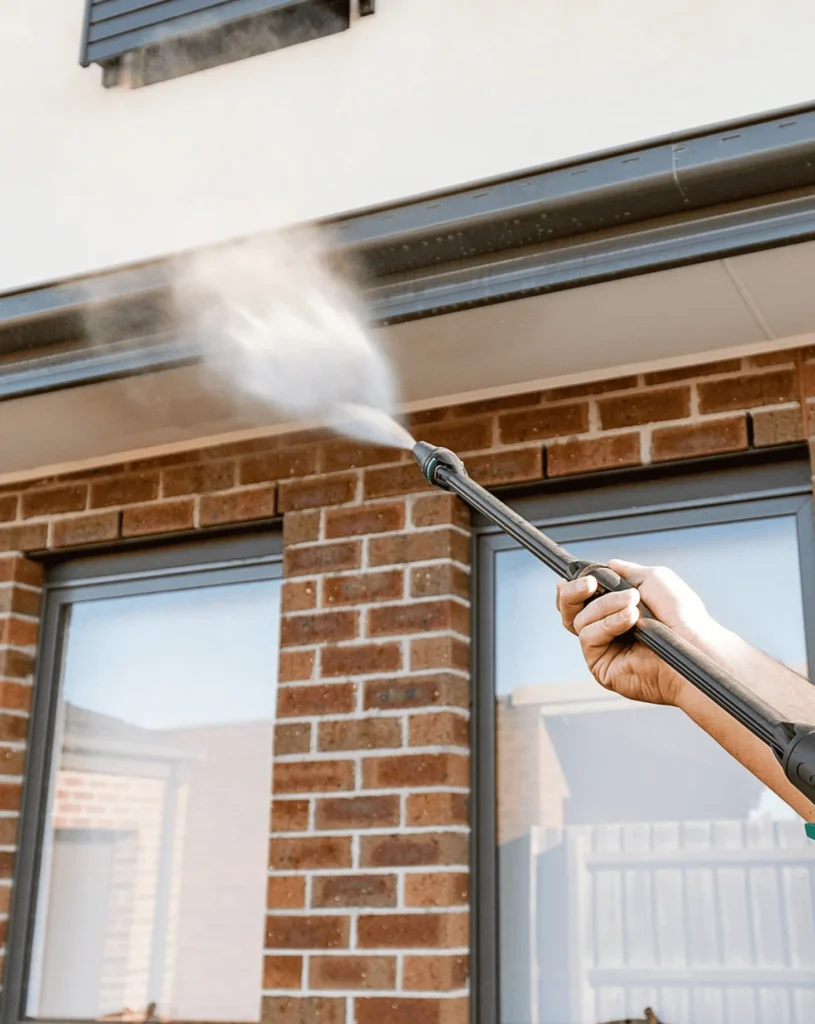
Cleaning glass surfaces and windows with a pressure washer requires a light touch to avoid cracking or etching. Follow these steps for a spotless, streak-free finish:
- Low Pressure: Set the pressure washer below 500 PSI. Glass surfaces are delicate, and too much pressure can be damaged.
- Wide Nozzle: Use a 40 degree nozzle to create a wide spray pattern that won’t harm the glass or its seals.
- Mild Detergent: Use a glass-specific detergent and make sure it’s thoroughly rinsed off to avoid streaks. Don’t use harsh chemicals that can weaken the window seals.
- Safety Tips: Always keep a safe distance from the glass surface and never point the high-pressure stream directly at the edges or corners of windows.
Pressure Washing Outdoor Furniture: Keep Your Patio Clean

Outdoor furniture can get dirty, dusty, and mildewy quickly, so regular cleaning is essential. Here’s how to pressure wash your outdoor furniture:
- Pressure Setting: Use low to medium pressure, 1200-1500 PSI, depending on the material of the furniture.
- Material Specific Cleaning: For wooden furniture use a wood safe detergent and avoid hot water which can warp the wood. For metal furniture you may need to use higher pressure for stubborn stains.
- Spray Wand Technique: Hold the spray wand at a safe distance to avoid stripping paint or causing dents. Move in even, sweeping motions to cover the whole surface without lingering in one spot.
- Final Rinse: After washing, rinse the furniture with cold water and let it dry completely before use.
Safety and Best Practices for Pressure Washing
Pressure washing can be risky if not done right. Here’s what to keep in mind:
- Protective Gear: Always wear safety gear, safety glasses, gloves and protective clothing to protect yourself from high pressure water and flying debris.
- Electrical Safety: Tape over outdoor outlets and electrical outlets with waterproof tape so water can’t get in during the cleaning process. Make sure your pressure washer is plugged into a GFCI-protected outlet.
- Nozzle Selection: Choose the proper nozzle for the job. A 15 degree nozzle gives you a narrow powerful stream, a 40 degree nozzle gives you a wider more gentle spray. Don’t use the wrong nozzle and damage the surface.
- Safe Distance: Keep a safe distance from the surface to avoid injury or damage. Start further away and move closer if needed, but never put the nozzle too close to the surface.
- Regular Maintenance: Do regular maintenance on your pressure washer, check the water inlet, inspect the hose for leaks and make sure the detergent reservoir is clean.
Professional Pressure Washing Services: When to Call in the Pros

While DIY pressure washing can work for small jobs, there are times when you need to call in the experts:
- Complex Jobs: For large commercial buildings, delicate materials or surfaces with tough stains, a professional pressure washing company has the expertise and equipment to do the job safely and correctly.
- Time and Effort: If you’re short on time or the job requires special cleaning solutions, hiring a pro will save you time and get the job done thoroughly.
- Risk of Damage: For surfaces that are prone to damage like softwood or old paint a professional pressure washing service can prevent damage by using the right techniques and equipment.
FAQ
Can I use a pressure washer on all exterior surfaces?
No, some surfaces like delicate materials or soft surfaces can be damaged by high pressure water. It would be best if you used the correct pressure and nozzle for the surface you are cleaning.
How often should I pressure wash my home’s exterior?
Frequency of pressure washing depends on the material and environment. Once a year is enough to prevent dirt, mold and mildew buildup on common surfaces.
What nozzle options are available for different surfaces?
Nozzle options depend on the surface. A 15-degree nozzle is suitable for tough stains, and a 40-degree nozzle is ideal for delicate surfaces like glass or vinyl siding.
What should I do if I damage a surface while pressure washing?
If you damage a surface, stop immediately and assess the damage. Depending on the extent, you may need to repair or consult a professional pressure washing service for advice.
What are the costs for professional pressure washing services?
Cost of pressure washing depends on the size of the area, surface and level of cleaning. It’s worth the investment to have it done safely and effectively especially for larger or more complex jobs.
How do I pressure wash elevated surfaces or areas with electrical outlets?
For elevated surfaces, use a ladder with stabilizing equipment and make sure your pressure washer hose has enough reach. Cover electrical outlets with waterproof tape and do not direct water near them to prevent electrical hazards.